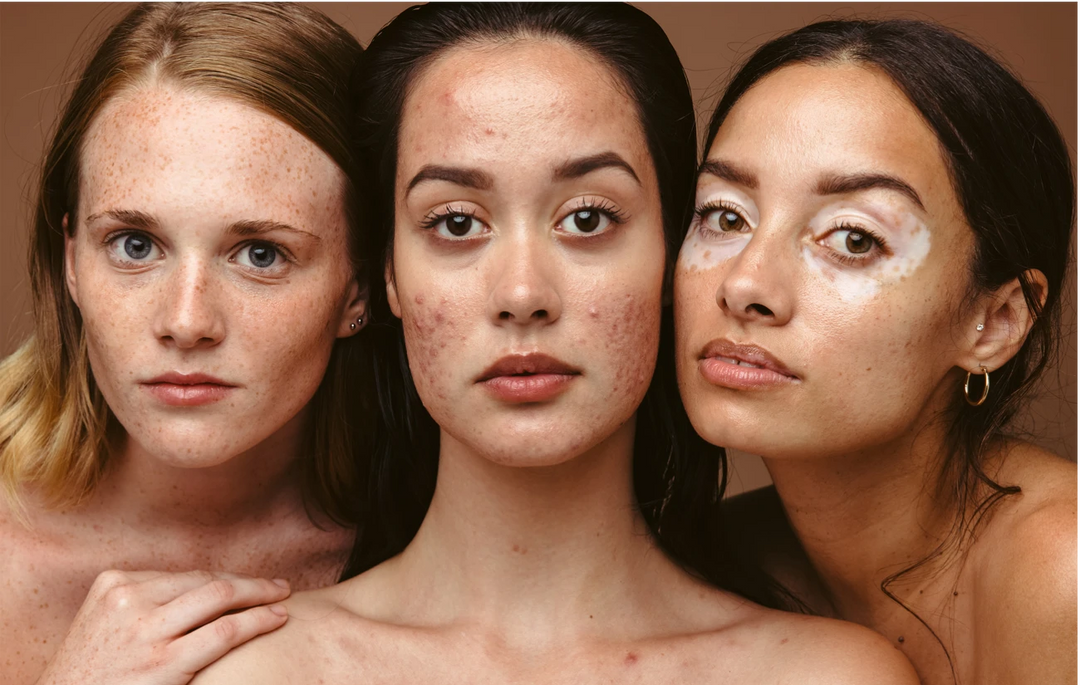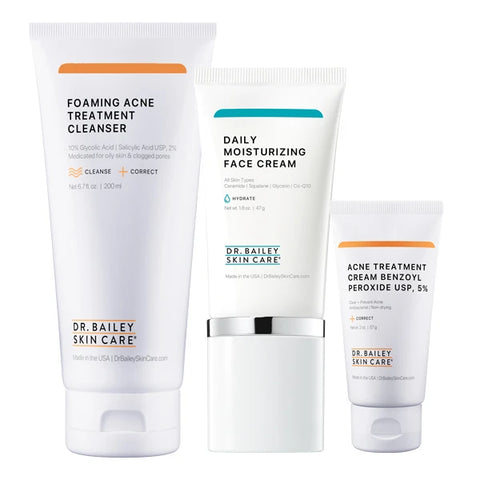Common Reasons Why Your Acne Treatment Might Not Be Working

There are common reasons why your acne treatment might not be working - but they are often elusive to even trained physicians - including dermatologists. Sometimes the presence of unexpected germs infecting or contributing to pimples is all that needs to be addressed to clear stubborn acne. The trick is to consider the possibility!
New Ideas for Acne Treatment from a Dermatologist
There are different reasons why people get pimples. If your acne treatment is not working then maybe your acne isn't "just" acne. You may actually have one of the less common reasons for pimples or even a bacterial infection of your pimples that makes them much more inflamed and resistant to acne treatment products.
Figure out the right diagnosis for your pimples so that you can add specialized treatment products to finally clear up your acne.
Do you feel like your acne treatment has stopped working, or that it never worked very well in the first place?
In my dermatology practice, patients with pimples usually have one of the following problems:
-
Acne Vulgaris, the most common form of acne due to the bacteria C. acnes (formerly called P. acnes).
-
Pityrosporum Folliculitis, which is also really common and due to the yeast called Pityrosporum (also called Malassezia).
-
Staphylococcal Folliculitis, which is really an infection of the hair follicles/pores and skin caused by the bacteria Staphylococcus aureus.
-
Gram-Negative Folliculitis, which is an infection by a less common group of bacteria that often occurs because of acne-treatment medicines!
Telling which of these you might have sounds really complicated, but it’s actually not. The important point is that if you have one of the folliculitis acne-like conditions, you need different treatment to clear up your pimples. If you think you have one of these forms of acne, talk with your doctor about getting the right treatment. Here's what you need to know:
How do you tell if your acne is caused by the classic type of acne called acne vulgaris?
This is the most common reason for pimples, and it's what we all think of as acne. People with acne vulgaris have both blackheads and pimples, usually around the nose, cheeks and chin as well as the forehead.
The pimples may gradually spread to the neck and back. As this form of acne worsens, the pimples and blackheads get bigger and more numerous. In this type of acne the skin is usually really oily.
Acne vulgaris responds to a really good acne skin care routine such as my Ultimate Acne Solutions Kit.
Topical acne-treatment products aim to unclog the blackheads in the pores using keratolytic ingredients (that break up blackheads) such as salicylic acid (great for penetrating into oily pores), glycolic acid (brightens skin and breaks up blackheads) and benzoyl peroxide (an ingredient that has broad medicated action against bacteria including the acne causing bacteria C. acnes). Benzoyl peroxide is the best acne medicine for reducing C. acnes bacteria and is even more effective than prescription topical antibiotics.
My Ultimate Acne Solutions Kit is medicated and contains all of the best ingredients to treat acne vulgaris.
How do you know if you have Pityrosporum folliculitis type of 'fungal' acne?
Pimples and clogged pores happen with this form of acne, too. But they are in different areas of your skin, and they look different than in acne vulgaris. They may coexist with acne vulgaris so you may actually have both reasons for pimples. If so, you need to treat them both!

The pimples and clogged pores of Pityrosporum folliculitis usually start on the forehead, the nose and along the jaw line. There are often little pimples on the neck, at the hairline and in the little indentation below the ear. They also happen on the chest and back.
The key points are that there are often millions of little pimples and clogged pores on the forehead, and many of the clogged pores are covered over by skin instead of open like blackheads. The pimples are really bright red, almost like a bug bite and they often both itch and hurt. There may even be pimples or dandruff on the scalp.
You are also more likely to get Pityrosporum folliculitis if you sweat often, such as if you are an athlete or live in a hot climate. That’s because this type of acne is due to an overgrowth of a normal skin yeast germ called Pityrosporum (also called Malassezia), and the germ grows really well on sweaty, oily skin in predisposed people.
You can have both acne vulgaris and Pityrosporum folliculitis together so I treat them both when I suspect Pityrosporum yeast is play a role in a person's acne problems. - Dr. Bailey
In fact, the C. acnes germ seems to help the Pityrosporum yeast wreak havoc with the skin. Thus, you want to treat them both.
My Pityrosporum Folliculitis Kit contains medicated ingredients to fight both C. acne and acne vulgaris plus ingredients to fight the Pityrosporum yeast that causes 'fungal' acne. Target 'fungal' acne on both back and chest.
How does this kit differ from the acne vulgaris kit?
Obviously, treatment of "PF" needs something that will reduce the growth of the Pityrosporum yeast, and regular acne medicines don’t. My favorite simple solution for Pityrosporum folliculitis is to use soaps and cleansers with a full 2% pyrithione zinc.

I recommend my natural and gentle pyrithione zinc fortified soap called Calming Zinc Bar Soap for the face. I have my patients alternate this with the Foaming Acne Treatment Cleanser in the Ultimate Acne Solutions Kit.
I recommend Foaming Zinc Cleanser to treat Pityrosporum folliculitis on the back, neck, chest and scalp. It is also a great solution for really tough and oily facial skin. Because it foams so well, it is the best solution for people with facial hair too.
How can you tell if your pimples are due to Staphylococcal folliculitis or gram-negative folliculitis infections?
These are skin infections and require prescription oral antibiotics that specifically kill these types of germs. You need to go to your doctor, ideally, someone specialized in treating skin problems such as a dermatologist because the diagnosis is not always obvious or easy to make.
Staph. folliculitis is caused by the Staphylococcus bacteria that can also cause impetigo.
Over 25% of everyone you know carries this germ on their body. Most of the time it doesn’t cause any problems, but it can. One such skin problem looks like acne, with pimples and white heads.
This can occur anywhere on the body, including the usual acne vulgaris places on the face and back. Any break in the skin, including injuries or your acne lesions, can become infected with Staph.
When pimples become infected with Staph., they get really big and are much more severe than normal. The infection can happen gradually or abruptly. - Dermatologist Dr. Cynthia Bailey
Regular acne treatments don’t work against Staph. Your doctor needs to do a culture of your pimples (a test for the bacteria) to tell if you have a Staph. infection and then prescribe the correct antibiotic. If you are not getting better on your acne medicines, ask your doctor if a culture is appropriate.
What is gram-negative folliculitis?
This is the strangest of all these conditions that cause pimples and doctors often miss the diagnosis in my observation.
Gram-negative bacteria don't normally cause skin problems but this infection of pimples happens when doctors do a good job using antibiotics to kill the C. acnes bacteria and other normal skin germs. When these bacteria are gone, the gram-negative bacteria move into the pores and start causing tender red pimples.
I suspect a gram-negative folliculitis when a patient's pimples (not their blackheads) all of a sudden get really bad in spite of being on antibiotics. - Dermatologist Dr. Cynthia Bailey
The gram-negative germ is not killed with the acne antibiotics and needs to be treated by different types of antibiotics that we don’t usually use to treat acne. This is one of the most common reasons that acne patients come to see me after being treated by another doctor. It’s easy to fix gram-negative folliculitis if you know to look for it. This infection is one of the important reasons I try to get my acne patients off both oral and topical antibiotics as soon as possible.
Your entire skin care routine needs to prevent acne.
The final important point is that if you suffer from acne then every product you use on your acne-prone skin needs to help your skin resist acne. Don't use acne treatment products combined with other products that cause acne or skin irritation. Don't forget to use sunscreen either because it helps prevent hyperpigmented acne scars.
I create a Complete Skin Care Routine™ that supports acne clearing. It involves using the 4 essential skin care steps to CLEANSE CORRECT HYDRATE PROTECT™ acne clearing using synergistic acne-friendly medicated products. Your skin care routine needs to provide all these steps in order to stay healthy and resist acne and acne scarring.
Click here to learn more about the acne treatment products that I have used in my dermatology practice for years such as my Pityrosporum folliculitis kit that addresses acne vulgaris, Pityrosporum folliculitis and helps to prevent recurrence of gram-negative folliculitis all in one skin care routine.
Remember, this information is intended to be educational, giving you a better understanding of the range of acne problems that affect the skin so that you can have a valuable discussion with your doctor of skin care professional. It isn’t intended to give a specific diagnosis or treatment for your skin problem.



